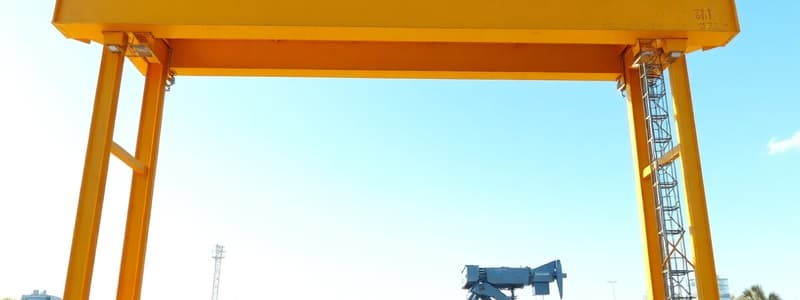Podcast
Questions and Answers
What is a key characteristic that distinguishes a truss bridge from a beam bridge?
What is a key characteristic that distinguishes a truss bridge from a beam bridge?
- It uses a solid structure as its primary support.
- It has a shell structure that is hollow on the inside.
- It incorporates a brace made of triangles for added strength. (correct)
- It relies on retaining walls to increase stability.
Which architectural principle suggests that the design of a structure should primarily be based on its use?
Which architectural principle suggests that the design of a structure should primarily be based on its use?
- Structural Integrity
- Material Efficiency
- Form Follows Function (correct)
- Load-Bearing Priority
Which of the following structures is the best example of a frame structure?
Which of the following structures is the best example of a frame structure?
- A brick wall.
- A sports dome.
- A skyscraper. (correct)
- An igloo.
Which of the structures below is an example of a shell structure?
Which of the structures below is an example of a shell structure?
What does the term 'magnitude' refer to in the context of forces?
What does the term 'magnitude' refer to in the context of forces?
Which of the following best describes a dynamic load?
Which of the following best describes a dynamic load?
What type of internal force is experienced when a rope is used to pull an object?
What type of internal force is experienced when a rope is used to pull an object?
Which characteristic of a structure would be considered its 'form'?
Which characteristic of a structure would be considered its 'form'?
Which of these scenarios best demonstrates the application of a 'shear' force?
Which of these scenarios best demonstrates the application of a 'shear' force?
Which of these structures primarily relies on cables for support?
Which of these structures primarily relies on cables for support?
A device that measures the temperature of a room is an example of what?
A device that measures the temperature of a room is an example of what?
What is the purpose of ergonomics, as applied to work environments?
What is the purpose of ergonomics, as applied to work environments?
What does the 'line of symmetry' describe?
What does the 'line of symmetry' describe?
Flashcards
Dynamic Load
Dynamic Load
A force that can change when acting on a structure. Think of snow accumulating on a roof - it can cause the roof to collapse.
Internal Force
Internal Force
A force that acts within a structure. Examples include compression, shear, torsion, and tension.
External Force
External Force
A force that acts on an object or structure from the outside. These forces can be caused by things like gravity, wind, or water.
Form
Form
Signup and view all the flashcards
Function
Function
Signup and view all the flashcards
Force
Force
Signup and view all the flashcards
Shear
Shear
Signup and view all the flashcards
Torsion
Torsion
Signup and view all the flashcards
Truss Bridge
Truss Bridge
Signup and view all the flashcards
Form Follows Function
Form Follows Function
Signup and view all the flashcards
Frame Structure
Frame Structure
Signup and view all the flashcards
Shell Structure
Shell Structure
Signup and view all the flashcards
Solid Structure
Solid Structure
Signup and view all the flashcards
Study Notes
Types of Loads
- Static Load: A load whose size, position, and direction remain constant.
- Dynamic Load: A load whose size, position, or direction changes while acting on a structure (e.g., snow).
Forces
- Internal Force: A force acting within a structure (e.g., compression, shear, torsion, tension).
- External Force: A force acting outside a structure (e.g., gravity, wind, water).
- Force: Any push or pull. Forces act on all structures.
- Shear: A force pushing in opposite directions.
- Torsion: A twisting force.
- Tension: A stretching force that expands or lengthens a structure.
- Compression: A force squeezing or pressing something together.
Structure Properties
- Form: The shape, size, and material of a structure.
- Function: The purpose or ability of a structure to do something.
Structural Elements and Design Principles
- Sensor: A device that detects or measures a specific condition (e.g., heat, light).
- Ergonomics: The efficiency of people in their work.
- Symmetry: When an object is the same on both sides. In structures, it relates to balance and harmony.
- Aesthetics: A sense of beauty or appeal.
- Line of symmetry: An imaginary line dividing an object into equal halves.
- Suspension Bridge: A bridge where cables are suspended from towers to support the load.
- Beam Bridge: A bridge with a horizontal beam supported by piers.
- Arch Bridge: A bridge with a semicircular shape supported by abutments (retaining walls).
- Truss Bridge: A bridge similar to a beam bridge, but uses triangular braces for extra support.
Structural Principles
- "Form Follows Function": The principle that the shape of a structure should relate to its intended use.
- Frame Structure: A structure with a frame (like a skeleton), which holds the building upright (e.g., Apartments, condos, skyscrapers).
- Shell Structure: The structure is hollow on the inside, but has a strong outer shell (e.g., sports domes, igloos, Sydney Opera House).
- Solid Structure: A structure with little or no space inside (e.g., bricks, blocks).
- Magnitude: The power of a force.
Studying That Suits You
Use AI to generate personalized quizzes and flashcards to suit your learning preferences.




